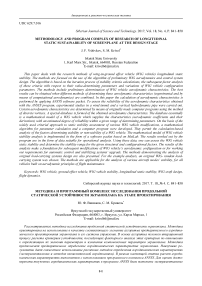Methodology and program complex of research of longitudinal static sustainability of screen plane at the design stage
Автор: Vshivkov J.F., Krivel S.M.
Журнал: Сибирский аэрокосмический журнал @vestnik-sibsau
Рубрика: Авиационная и ракетно-космическая техника
Статья в выпуске: 4 т.18, 2017 года.
Бесплатный доступ
This paper deals with the research methods of wing-in-ground effect vehicle (WIG vehicle) longitudinal static stability. The methods are focused on the use of the algorithm of preliminary WIG aerodynamics and control system design. The algorithm is based on the iteration process of stability criteria calculations, the subsequent factor analysis of these criteria with respect to their value-determining parameters and variations of WIG vehicle configuration parameters. The methods include preliminary determination of WIG vehicle aerodynamic characteristics. The best results can be obtained when different methods of determining these aerodynamic characteristics (experimental and by means of computational aerodynamics) are combined. In this paper the calculation of aerodynamic characteristics is performed by applying ANSYS software packet. To assess the reliability of the aerodynamic characteristics obtained with the ANSYS program, experimental studies in a wind tunnel and a vertical hydrodynamic pipe were carried out. Certain aerodynamic characteristics are determined by means of originally made computer programs using the method of discrete vortices. A special database is formed of the obtained aerodynamic characteristics. The database essentially is a mathematical model of a WIG vehicle which supplies the characteristics (aerodynamic coefficients and their derivatives) with an estimated degree of reliability within a given range of determining parameters. On the basis of the widely used criterial approach to static stability assessment of various WIG vehicle modifications, a mathematical algorithm for parameter calculation and a computer program were developed. They permit the calculation-based analysis of the factors determining stability or non-stability of a WIG vehicle. The mathematical model of WIG vehicle stability analysis is implemented in the form of a software packet based on MatLab. The results worked out by the program are in the form of data suitable for operational analysis. Using these data, one can assess the WIG vehicle static stability and determine the stability range for the given structural and configurational factors. The results of the analysis make a foundation for subsequent modifications of WIG vehicle's aerodynamic configuration or for working out requirements for automatic control and stabilizing systems' upgrade. The methods demonstrating the analysis of original load-carrying systems design are also presented. For the example analysis, an original WIG- tandem load- carrying system was chosen. The methods are applicable for the analysis of various aircraft modes' stability, for all vehicles built on aerodynamic principles of flight maintenance.
Wig vehicle, ground-effect vehicle, wig vehicle stability, longitudinal static stability, wig-craft design, flight dynamics
Короткий адрес: https://sciup.org/148177769
IDR: 148177769 | УДК: 629.7.016
Текст научной статьи Methodology and program complex of research of longitudinal static sustainability of screen plane at the design stage
Introduction. Design of wing-in-ground effect vehicles (WIG vehicles) with pre-determined stability and controllability characteristics is a complex and topical task. The requirements of their stability and controllability are more demanding as compared to the design standards of other aircraft with comparable aerodynamic characteristics, such as airplanes. That is determined by the demands of flight safety, as WIG vehicles fly at a high speed and quite close to the water or ground surface. WIG-craft handling qualities (either set initially or specified by an automatic flight monitoring system) must provide fine control of flight and the craft’s specified alignment with the underlying surface within the given flight envelope. Besides, WIG vehicles’ aerodynamic characteristics (aerodynamic coefficients and their derivatives) depend on the distance of the given distinguished point of the craft (in this paper – the center of mass) from the underlying surface, and on the position of the center of mass as the point of the aircraft rotation. Unlike with airplanes, here the range of significant influence of these factors corresponds to the main operational range of WIG vehicles’ flight parameters. It is difficult to overestimate the importance of solving the problem of specifying the stability and controllability characteristics of the craft at the preliminary design stage, as the correction of design errors in aerodynamic configuration of the aircraft can’t be fully completed at subsequent design stages. That is why the article deals with the problem so urgent for the development of aircraft engineering.
Subject of research. The purpose is to work out methods and a packet of computer programs for assessing the WIG vehicle static stability at the stage of preliminary design using mathematical modeling and method studies. These can help to assess the applicability of the methods and programs offered for WIG-craft aerodynamic design. Note: the ideology of mathematical modeling of WIG vehicle flight dynamics this paper is based on is acquired from Ref. [1], the aerodynamics and motion designations and parameter structuring are specified in accordance with Ref. [1–3].
It is known that an aircraft (WIG vehicle, airplane, etc.) is statically stable with respect to one of the parameters, if its changing causes force factors (forces or moments) that tend to eliminate the increment of this parameter. Longitudinal static stability specifically shows itself in longitudinal motion, i. e. when the aircraft is moving along its own symmetry plane. This paper defines the longitudinal static stability of WIG vehicle as the static stability of its two parameters: the angle of attack (pitch) and the altitude of flight above the ground-effect plane (distance). The longitudinal stability characteristics of a WIG vehicle is determined by two groups of factors. The first group is determined by the aerodynamic and mass configuration of the aircraft. The second group includes the initial flight mode parameters, the center of mass location, the flying weight and other variable parameters [3–5].
Calculation methods of longitudinal stability parameters. Characteristics of the program packet . A lot of works are devoted to solving the problem of providing WIG-craft stability in longitudinal motion, the most essential being the works of R. D. Irodov and V. I. Zhukov [6; 7]. They offer a criterial approach to WIG vehicle stability assessment based on the analysis of the angle of attack and distance from the ground-effect plane. It should be noted that in most works devoted to the assessment of WIG vehicle stability, including those published abroad, the same approach is either applied or developed (Ref. [8–10]).
In this paper, two approaches are used to evaluate WIG static stability in longitudinal motion.
The first is based on the theoretical propositions of Ref. [6].
This paper analyses the basic system of equations describing WIG vehicle longitudinal motion, which does not differ in form from the equations used for airplane parameters calculations and is in the same form as in Ref. [1; 3]:
S = g ( n x . - sin «X
— = g (Пу - cos 6), dt V yа d29 _ Mz dt2 = Iz ’ dh
= V sin 6.
dt
Here g – is free fall acceleration; n and n – tan-xа yа gential and normal high-speed overload respectively; t – time; V – true airspeed (in case of the absence of airflow velocity along the underlying surface); θ – flight path slope angle; 9 - pitch angle; h - flight altitude (relative distance from the ground-effect plane, distance from the aircraft’s center of mass to the ground-effect plane); Mz – longitudinal moment.
With certain assumptions, the terms of aperiodic and oscillation stability of WIG vehicle were obtained. As on the cruiser flight modes c h < 0, c" > 0 (lift coefficient derivatives according to the distance and the angle of attack respectively), the stability criteria can be described as:
dmz d a
cya
c ya ГП
dm dh
ya
cya
ГП
< 0,
where c – lift coefficient for stable horizontal flight; ya ГП mz – WIG vehicle longitudinal moment coefficient. WIG vehicle is regarded as stable when ma < 0 or mh < 0 (longitudinal moment coefficient derivatives mz with
respect to the angle of attack α and distance h respectively) when c„ = const = c„ .
y a y a ГП
In accordance with this approach to evaluation of WIG craft static stability the following mathematical algorithm of derivatives calculation was worked out
m
a
z
dmz
d a Cya Cya гп
h и mz
dmz d h
СУа СУа ГП
(fig. 1).
On the block diagram fig. 1: xT – current center of mass location of the aircraft under consideration; h – specified relative distance from the ground-effect plane; cya – specified lift coefficient for stable horizontal flight; a ГП - angle of attack for horizontal flight with the specified parameters; h ГП – relative distances calculated with corresponding value of cya ; mz – longitudinal moment coefficient calculated for corresponding to the angle of attack and the distance in horizontal flight ( a ГП и h ГП ).
The complex of aerodynamic characteristics is determined with the help of ANSYS software packet. To estimate the range of kinematics parameters of ANSYS applicability to solving the given problems and the reliability of the results the model yields, a methodical research was done based on comparing the results of the calculations with the experimental data and modelling results obtained in researches of other authors [11–13].
Aerodynamic characteristics are presented as a mathematical model, describing dependences of aerodynamic coefficients on the parameters of flight and WIG vehicle configuration based on multidimensional approximation of data by exponential polynomials. The derivatives of aerodynamic coefficients with respect to the given parameters are determined by methods of numerical differentiation.
The second approach is classic for the aircraft of airplane type, where longitudinal static stability is essentially understood as stability with respect to the angle of attack in low-speed longitudinal motion; it also depends on the center-of-gravity positioning of the aircraft [1–3]. In this case, the aircraft is stable under condition dm of - < 0 . The simplified approach is dictated by the da necessity of WIG- craft’s static stability evaluation when it moves out of (or with negligible) wing-in-ground effect. Application of the first approach at a considerable distance from the effect plane often gives rather contradictory results of stability evaluation. Besides, certain examples of analysis of some aerodynamic configurations bring to conclusion that in several cases the simplified (second) approach to longitudinal stability evaluation within the total range of distances from the underlying surface is enough. In this case stability evaluation is made when the following conditions coincide: ma< 0 и mh < 0 (with no condition cya = const set up).
If the criteria m ^ < 0 and m h < 0 are not synchronized, it means that the aerodynamic configuration of WIG vehicle doesn’t provide its longitudinal static stability.
MatLab system and its Guide application are used as a mathematical modelling platform, allowing to work out original applications for Windows. Aerobatic 1.0 program application was made on this basis (fig. 2).
The program presents a multi-window structure interface, which allows step-by-step problem solving:
-
1. Formation of aerodynamic characteristics database for the aircraft under study. Stating the special task for analysis (when it is necessary to analyse several independent configurations or configurations derived one from the other) (fig. 3).
-
2. Analysis of the aircraft aerodynamic characteristics using visualization methods and mathematical modelling of its aerodynamics by means of data processing, calculation of secondary aerodynamic characteristics and derivative aerodynamic coefficients within the given working process [1].
-
3. Stating the succession of calculations and initial data (fig. 4.) The program allows to calculate and make mathematical experiments both within the program and using other external software (for example, an optimization program packet).
-
4. Analysis of modelling results based on multi-variant presentation of results in numerical terms along with visualization methods, including the analysis of separate configuration components within the range of generalized results (for example, within stability criteria values).
Methods and results of longitudinal stability estimation . The subject of research is a non-standard WIG
vehicle configuration. The given configuration is of two load-carrying surfaces mounted one behind the other in a tandem (fig. 5). The front wing – trapezoidal, swept at the leading edge, flat, of a relatively thing section – makes a small rigging angle of incidence with the longitudinal axis of the aircraft. The back wing – with a straight leading edge, swept back at the trailing edge – has a considerable rigging angle and is of an anhedral wing angle. The back wing is dome-shaped, and its trailing edge lies in the same plane. The horizontal tail of rectangular form is mounted in this configuration with a considerable elevation as to the load-carrying system of front and back wings.
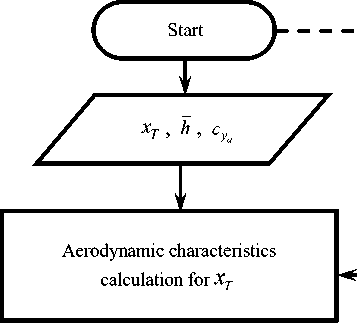
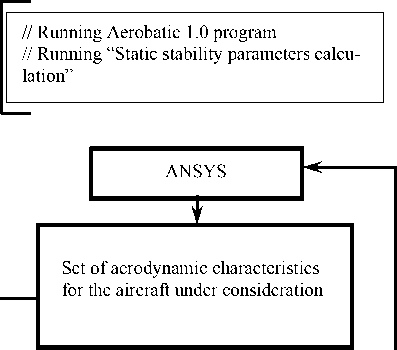
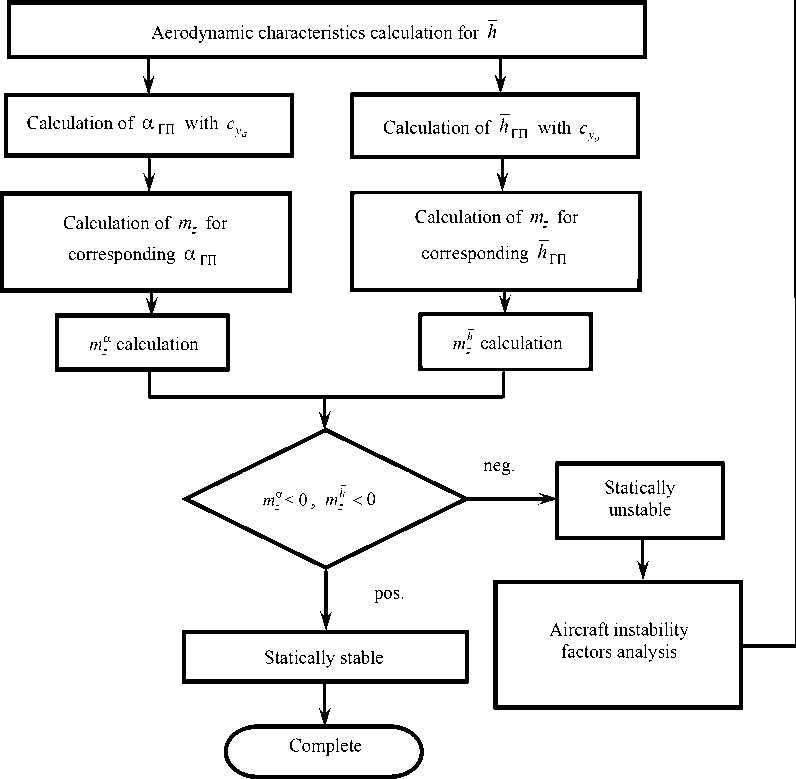
Fig. 1. Block diagram of m Z и m h calculation when cy^ = const
Рис. 1. Блок-схема расчета m ^ и m h для случая c y a = const
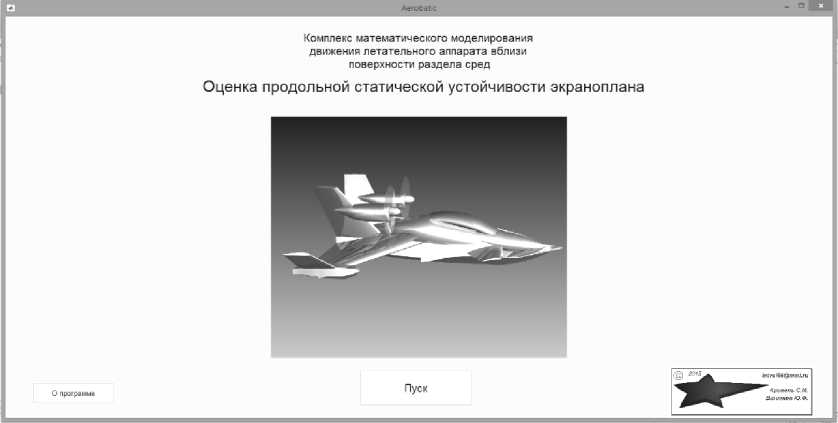
Fig. 2. Aerobatic 1.0 starting window
Рис. 2. Стартовое окно программы Aerobatic 1.0

Fig. 3. Window of the analyzed object choice
Рис. 3. Окно выбора объекта исследования
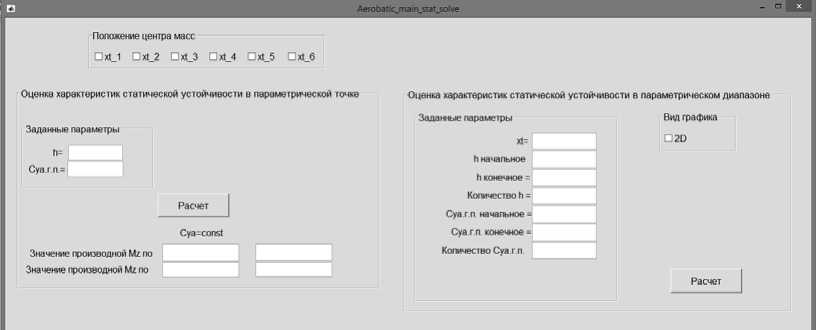
Fig. 4. The main processing window for calculation and feeding the initial data
Рис. 4. Основное управляющее окно порядка выполнения расчетов и задания исходных данных
It should be noted that ma z и m h parameters for the set configuration are determined by the flight parameters and the center of mass location. Here the character of dependence of longitudinal moment coefficient on the angle of attack m z ( a ) and distance mz ( h ) differs qualitatively (fig. 6, 7). We can conclude that the sign of the derivative m a in case c y a = const is specifically determined by the order of mz ( a ) variation in “correction” of the distance h . “Correction” of the distance h is determined by the necessity to keep cy a = const when changing the angle of attack α. The increase of the angle of attack α (increase of cya ) demands the corresponding increase of the distance h (decrease of cy a ). This setting can be illustrated by the following example (fig. 8). Setting the lift coefficient c y a = 0.56 (the diagram above) results in the longitudinal moment coefficient mz increase with the angle of attack α increase (the diagram below). This can be explained by the fact that the increase rate of m z due to the unavoidable “correction” of distance h (its increase) is higher than the decrease rate of m z due to the increase of the angle of attack a. For the example given mz ( a ) > 0, that means that the WIG vehicle is statically unstable in longitudinal motion when c y a = 0.56.
The results of the modelling outline the static stability and instability ranges of WIG vehicle (fig. 9). The range of parameters within which the stability of WIG vehicle can be sustained is limited both by extreme aft and forward center-of-gravity position. Stability is provided within a narrow range of center-of-gravity and flight parameters. Application of stability criteria in the form (2), considering that the implementation of one of the conditions - ma < 0 or mh < 0 - is enough, logically results in the necessity of implementation of both conditions. The given setting can be used as an instrument of modelling quality control and is illustrated by the data of fig. 9.
However, the application of stability criteria (2) at distances greater than 1 (at distances of low wing-in-ground effect influence on WIG vehicle aerodynamic characteristics) doesn’t correspond to the results of using the simplified approach based on the stability criterion m z " < 0.
The representation of the static stability conditions in the form [5] is more informative from the point of view of WIG vehicle aerodynamic configuration analysis:
x Fh — x F a < 0, (3)
where xF h , xF a are the angle-of-attack and distance foci coordinates.
The results of basic configuration modelling of the load-carrying system are shown in fig. 10. It is obvious that the location of the distance focus x F h doesn’t depend on the center of mass location. The location of the angle-of-attack focus xF a considerably depends on the center of mass location, as it is the WIG vehicle rotation point. The rotation point location determines the WIG vehicle attitude to the underlying surface when the angle of attack (and the aerodynamic characteristics) are changed. In a certain sense, the model data bring to conclusion that the WIG vehicle’s center-of gravity location control does not allow effective influence on the aircraft stability in longitudinal motion and specifically on the range of stable modes of flight. However, the position of the center of mass can have a significant effect on the range of WIG vehicle static stability in respect to the angle of attack, which in turn determines the parameters of the aircraft perturbed motion.
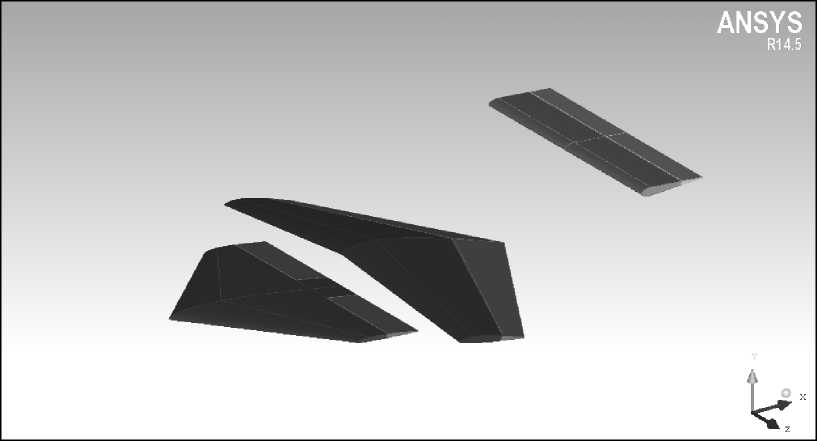
Fig. 5. General configuration in cross-section
Рис. 5. Общий вид компоновки в плане
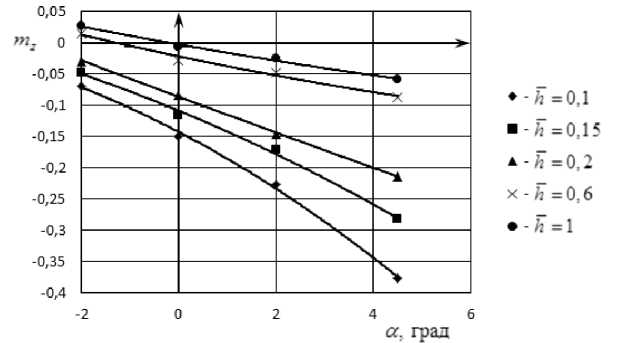
Fig. 6. Dependence of longitudinal moment coefficient on the angle of attack m z ( a ) for varied distances h (extreme forward center – of-gravity)
Рис. 6. Зависимость коэффициента продольного момента от угла атаки m z ( a ) для различных отстояний h (центровка – предельно передняя)
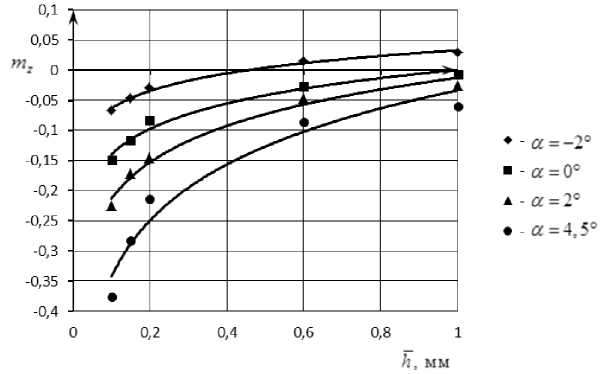
Fig. 7. Dependence of longitudinal moment coefficient mz on the distance h
( h )
for varied angles of attack α (extreme forward center – of-gravity)
Рис. 7. Зависимость коэффициента продольного момента mz
( h )
от отстояния h
для различных углов атаки α (центровка – предельно передняя)
Conclusion. It is obvious that the analysis of the WIG vehicle longitudinal static stability alone based on the criterial approach has a rather conventional practical significance for several reasons. First, the problem of determining the best (optimal, rational, etc.) relative position of the center of mass, foci of the angle of attack and distance, even when the requirements of static stability are fulfilled, remains a subject of investigation and of scientific publications’ argument (examples in [8–10]. Second, perturbed motion of WIG vehicle with the relatively intensive change of distance and, accordingly, change of aerodynamic characteristics and parameters, including static stability (fig. 10) result in the necessity of solving the stability evaluation problem using simulation models of WIG vehicle flight dynamics with reference to non-stationary constituents of aerodynamic characteristics [14]. Third, we have to point out that presently the paradigm of WIG vehicle flight control in ground-effect mode is in itself the subject of research and argument, also including the performance of automatic control and stability control systems [15]. As an example, there are attempts to find the proof for the concept of controlling WIG vehicle flight altitude by changing its velocity. As a rule, here every specified altitude of WIG vehicle’s flight corresponds to a certain horizontal flight velocity (in the absence of active control of the angle of attack and, consequently, on condition that cya = const). Nevertheless, the offered methodology, software, and the corresponding modelling results allow to evaluate the WIG vehicle static stability even at the stage of preliminary design plan, to outline the range of applicable construction and configuration factors.
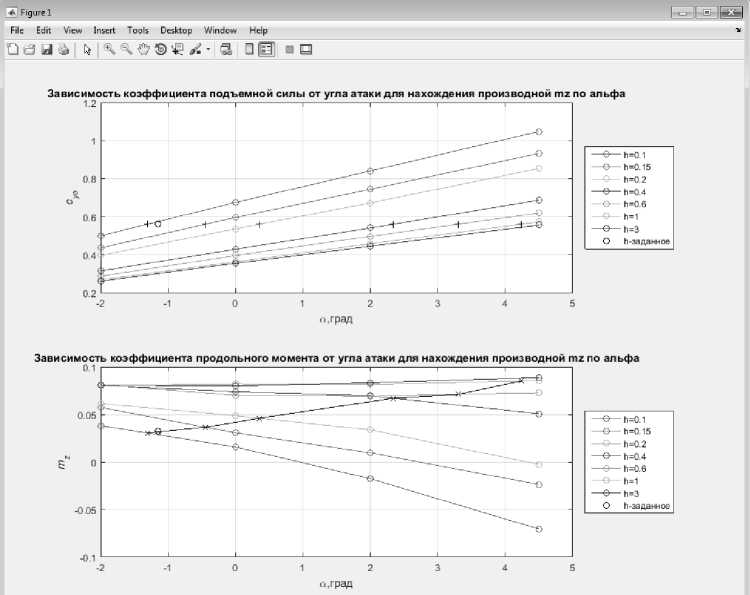
Fig. 8. The example of the derivative m ^
calculation when c„ = const y a
Рис. 8. Пример расчета производной m^ для случая cya = const отстояние h отстояние h
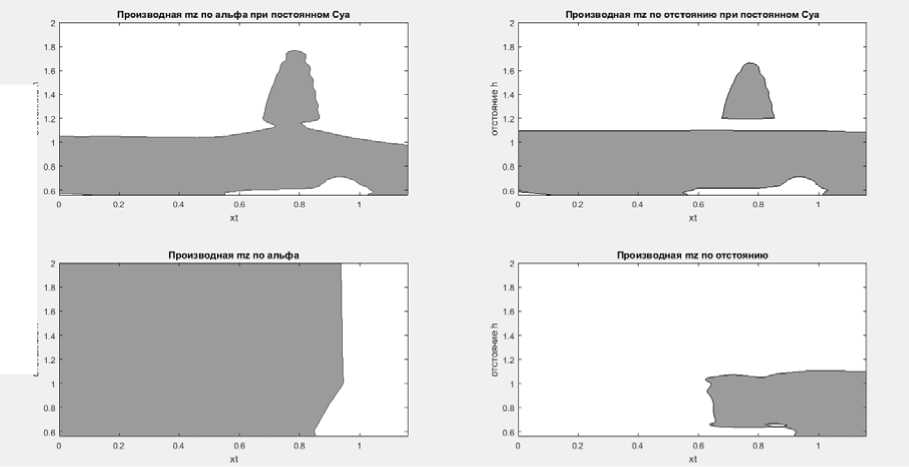
Fig. 9. Areas of longitudinal static instability (dark grey)
with respect to criteria
dmz da Icy”
, c < 0 and ya ГП
^L = c < 0
d h yaya ГП
(above)
and dm z < 0 and d a
dm < о dh
in the distance and relative center-of-mass location coordinates
Рис. 9. Области продольной статической неустойчивости (обозначены темным цветом)
и
dm по критериям —- c = c da I ya ya гп
< 0 и
dm z l = c < о d h cya cya ГП
(верхние графики)
dm
- < 0 и d a
dm- < о dh
в координатах отстояния и относительного положения центра масс
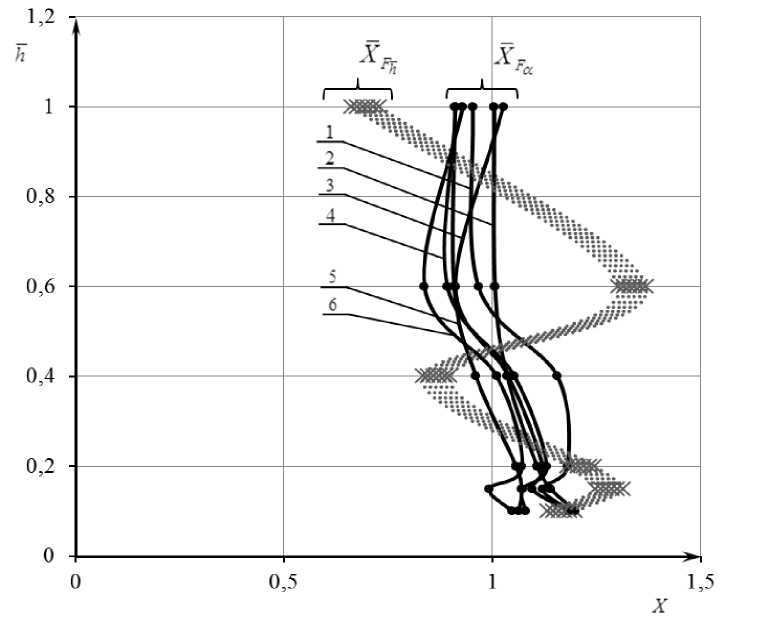
Fig. 10. Dependence of the distance foci locations x Fh and of the angle of attack xF a on the distance h and the center of mass location X T = 1.69673 :
1 - X T = 0.7653; 2 - X T = 0.99803; 3 - X T = 1.2313;
4 - X T = 1.46403; 5 - X T = 1.69673; 6 - X T = 1.9293
Рис. 10. Зависимость положений фокусов по отстоянию x Fh и углу атаки x F а от отстояния h и положения центра масс X T = 1,69673:
1 - X T = 0,7653; 2 - X T = 0,99803; 3 - X T = 1,2313;
4 - X T = 1,46403; 5 - X T = 1,69673; 6 - X T = 1,9293
Список литературы Methodology and program complex of research of longitudinal static sustainability of screen plane at the design stage
- Бюшгенс Г. С., Студнев Р. В. Динамика самолета. Пространственное движение. М.: Машино-строение, 1983. 320 с.
- ГОСТ 20058-80. Динамика летательных аппаратов в атмосфере. Термины, определения и обозначения.
- Тарасенков А., Брага В., Тараненко В. Динамика полета и боевого маневрирования летательных аппаратов. Ч. 2. Балансировка, устойчивость и управляемость: учебник для слушателей инженерных вузов ВВС/под ред. А. М. Тарасенкова. М.: ВВИА им. проф. Н. Е. Жуковского, 1973. 334 с.
- Белавин Н. И. Экранопланы. Л.: Судостроение, 1977. 232 с.
- Мещеряков И. Н. Влияние конструктивных и режимных параметров на устойчивость экраноплана вблизи опорной поверхности//Научный вестник МГТУ ГА. 2010. № 151. С. 175-180.
- Иродов Р. Д. Критерии продольной устойчивости экраноплана//Ученые записки ЦАГИ. 1970. Т. 1, № 4.
- Жуков В. И. Особенности аэродинамики, устойчивости и управляемости экраноплана. М.: Издательский отдел ЦАГИ, 1997. 81 с.
- Kornev N., Matveev K. Complex numerical model-ing of dynamics and crashes of wing-in-ground vehicles//AIAA, 2003-600: 41st Aerospace Sciences Meeting and Exhibit, Jan. Reno, Nevada, 2003.
- Computational Aerodynamics and Flight Stability of Wing-In-Ground (WIG) Craft/H. Wanga //7th Asian-Pacific Conference on Aerospace Technology and Science. 7th APCATS, 2013. C. 15-24. URL: http://www.elsevier.com/locate/procedia.
- Научно-технические проблемы создания транспортных экранопланов гражданского применения/Г. Л. Дегтярев //Вестник КГТУ им. А. Н. Туполева. 2000. № 3. С. 3-9.
- Вшивков Ю., Галушко Е., Кривель С. Комплексная оценка достоверности расчета аэродинамических характеристик сложных объектов с использованием ANSYS //Crede Experto: транспорт, общество, образование, язык. 2015. № 1 (03). URL: http://ce/if-mstuca.ru (дата обращения: 15.02.2016).
- Аэродинамические особенности и характеристики компоновок экраноплана схем «утка» и «тандем»/С. Ю. Братусь //Вестник ИрГТУ. 2016. № 5 (112). С. 168-180.
- Применение методов вычислительного эксперимента для определения аэродинамических характеристик экраноплана на крейсерском режиме движения/В. Н. Блохин //Вестник Нижегородского университета им. Н. И. Лобачевского. 2012. № 3(1). С. 147-154.
- Грязин В. Е., Стрелков В. В. Устойчивость, управляемость и принципы автоматизации управления экранопланом на крейсерском режиме полета//Ученые записки ЦАГИ. 2004. Т. ХХХV, № 3-4. С. 79-89.
- Небылов А. В. Проблемы, теория и системы автоматического управления экранопланов //XII Всерос. совещание по проблемам управления. М.: ИПУ РАН, 2014. URL: http://vspu2014.ipu.ru/proceedings/prcdngs/3391.pdf, свободный (дата обращения: 25.04.2017).

